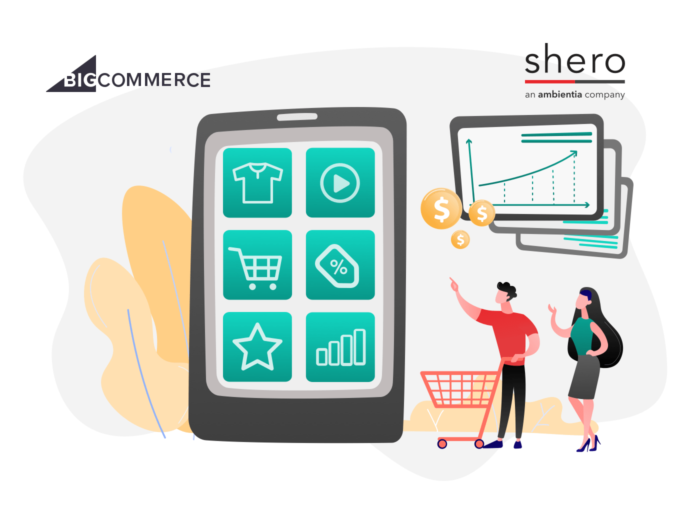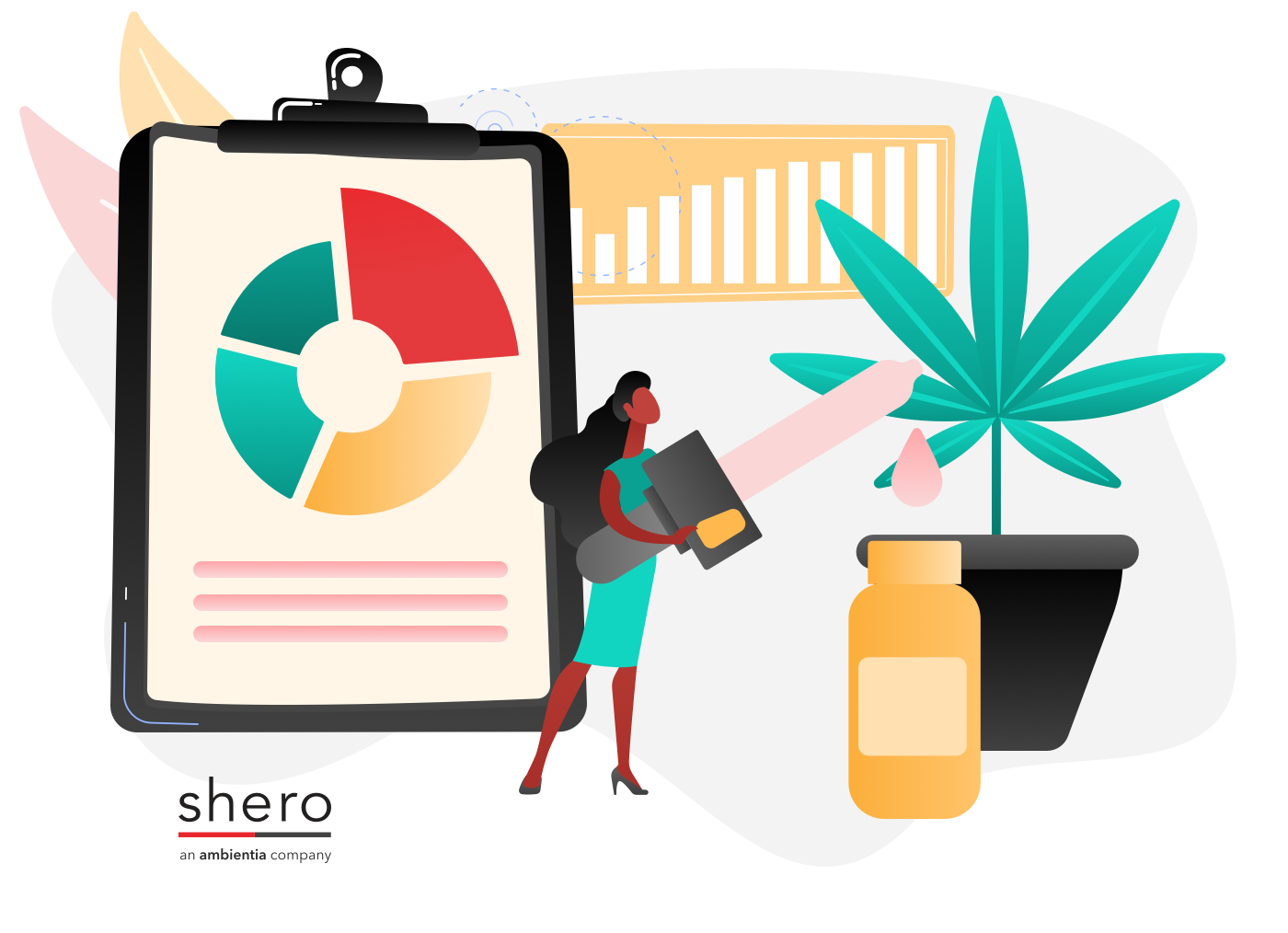When it comes to choosing an eCommerce platform, BigCommerce features a growing number of impressive tools each year.
The decision to go with one eCommerce platform over another relies heavily on features and functionality.
Don’t forget to check out our comprehensive guides to pricing, plans, and features for Shopify, Magento, and Bigcommerce.
But for now, here’s a rundown of our favorite popular BigCommerce features, including:
- Unlimited products, file storage, and bandwidth
- Single-Page Checkout
- Less downtime
- Coupons & Gift Certificates
- Product Videos
- Bulk Pricing
- Ratings & Reviews
- Product Swatches
- Customer Groups & Segmentation
- Abandoned Cart Saver
- Persistent Cart
- B2B Edition
Let’s dive in!

The Basics: Choosing an eCommerce Platform
To start, eCommerce platforms come in two basic types. The first: Self-hosted software, of which Magento by Adobe Commerce is an example.
This type of product is a one-time download or purchase, which you then own. From there, it’s up to you to acquire hosting, installation, setup, and support for the store yourself.
The second is Software as a Service, more commonly called SaaS. This type of platform combines the functionality of eCommerce software with the support of an ongoing service—most of the heavy technical lifting like hosting, technical support, and security maintenance provided by the software developer.
Popular SaaS platforms include Shopify and BigCommerce.
The choice between self-hosted eCommerce software and a SaaS platform is not a matter of “better” or “worse.” It depends greatly on the needs of your business.
Traditional software typically offers greater flexibility, allowing its owner to make choices about hosting, customization, and maintenance.
This freedom can be of great benefit for a company that has the resources to take advantage of it, but it comes with a lot of responsibility and (dare we say?) some risk.
Alternatively, a SaaS platform can radically simplify the setup of an online storefront by packaging hosting, maintenance, and support with the product itself.
A Place for SaaS
At Shero, we specialize in developing and supporting eCommerce websites. We love Magento’s powerful features and expandability. At the same time, we also recognize the complications of launching a customized eCommerce store. It can become daunting for a non-complex business with concerns about budget or ongoing maintenance.
For some clients, we recognize that the simplified workflow of a SaaS platform, like BigCommerce, is a great benefit and for these customers, we often recommend and support clients with our BigCommerce services.
You can also learn about our Shopify services. Yes, we are here to talk about BigCommerce, but this SaaS platform has practically become a household name and is worth exploring.
One reason we like and partner with BigCommerce is that it is highly customizable.
Like all SaaS platforms, BigCommerce operates on a closed system. This means that support and maintenance are included in the subscription.
On the other hand, BigCommerce provides a set of tools that developers can use to make a wide variety of customizations to an eCommerce site.
BigCommerce can be used with a default base theme, one of 10 free themes, and dozens of powerful professional themes that are available for purchase.
Themes can be heavily modified, regardless of which theme you choose. An eCommerce agency can customize your site to meet your store’s unique requirements and branding.
Its functionality can also be greatly expanded upon with support for custom scripts and a powerful API to handle all kinds of integrations. In short, a BigCommerce site doesn’t have to be cookie-cutter just because it’s on a SaaS platform.
Interested in seeing the wide range of customizations you can make? Check out these 7 Examples of Successful BigCommerce Websites
We also love BigCommerce’s impressive set of native features. Like other SaaS platforms, BigCommerce has an app store. Here, you can find integrations for purchase to extend a store’s capabilities.
Unlike some other SaaS platforms, BigCommerce comes out of the proverbial “box” with a suite of capabilities that can reduce or even eliminate the need for third-party extensions.
Here are 10 of our favorite features that are likely to require apps with other platforms, but come natively with BigCommerce. All these features are available with BigCommerce’s $79 “Plus” plan and above.
1. Unlimited products, file storage, and bandwidth
BigCommerce doesn’t impose limits on catalog size, storage space or the number of requests your website can receive in the space of a month.
This is true even at its entry-level “Standard” tier, so you don’t have to purchase a better plan to add more products or get better loading times.
The only cap BigCommerce sets is on actual sales, which are limited to $50k annually for the “Standard” plan, $180k for “Plus” and $400k for “Pro. Enterprise-level plans have no cap.
Like any website, your BigCommerce site works better when optimized with clean design and compressed assets. The benefit here is that you won’t have to pay for better bandwidth.
2. Single-Page Checkout
A streamlined checkout is crucial for conversions. Every step a customer takes toward the final purchase is an opportunity for a distraction or a change of mind.
BigCommerce has engineered a simple, single-page checkout that removes distractions and increases the likelihood that customers will complete the purchase.
3. Less downtime
Like most cloud-based solutions, BigCommerce boasts an impressive 99% uptime rate. This is an important detail for sales and for building customer trust—shoppers can rely on stores remaining open even during a holiday rush or flash sale.
This is in part because BigCommerce uses an off-site hosting solution like Amazon Web Services (AWS). Another upside of cloud hosting is that you won’t have to factor in the cost of maintenance and updates.
4. Coupons & Gift Certificates
All BigCommerce plans include a great set of tools that store owners can use to increase purchases and improve loyalty.
A flexible discount system allows you to offer special purchase incentives based on specified criteria. For example, a customer can buy one product and get another free, or get free shipping on orders over a certain amount.
All BigCommerce plans also include coupons. A coupon code is a useful method of encouraging visitors to sign up for a newsletter or create a member account.
Coupon codes are also excellent for tracking the effectiveness of a marketing campaign, by associating a unique coupon code with a particular advertisement.
Additionally, all BigCommerce plans come with the ability to create gift products, allowing your customers to buy a virtual gift certificate for any specified price range and have it automatically emailed to the recipient.
5. Product Videos
As a standard feature, all BigCommerce plans allow sellers to add videos to their products. The video can be added using a simple YouTube link and appears right on the product page. A product video is an attention-grabbing method of showcasing a product with an in-depth demonstration or sizzle reel.
6. Bulk Pricing
Bulk pricing is a feature that allows the seller to incentivize purchases at a higher quantity by offering bulk discounts.
This is very useful for products often purchased in multiples. It’s one of several off-the-shelf features that make BigCommerce a compelling choice for B2B stores.
There are various ways to offer bulk discounts. For example: by adding a percentage discount for each quantity tier, or by setting a fixed price per product for each tier.
Bulk discounts can also be simplified by applying them at the category level. In the “Plus” plan and above, they can be combined with customer groups, which is especially handy for B2B stores with retail and wholesale customers.
7. Ratings & Reviews
BigCommerce includes a simple system for customer reviews and ratings. This system can be activated with a single click and made available on any product page.
You can set reviews for manual or automatic approval, and set up management to help prevent spamming.
BigCommerce also provides a customizable template for email invitations to review recently purchased products. For sellers with more advanced needs, BigCommerce can be easily integrated with systems like Yotpo, but its default reviews and rating system is a great choice for starters.
8. Product Swatches
In all BigCommerce plans, products listings are allowed multiple variants for options like size, color or pattern.
BigCommerce provides several useful choices for formatting these options, such as dropdowns, checkboxes and size selectors. For products with visual variations, sellers can use color or image swatches, giving customers a quick preview of each variant.
9. Customer Groups & Segmentation
For sellers using the “Plus” plan and above, BigCommerce provides the ability to classify customers by group, also known as segmentation.
This feature can be used for stores of all kinds but is particularly important for B2B storefronts.
You can add segmented customers to a loyalty program that receives special offers, a membership group that receives discounts, a wholesale group with lower prices or a tax-exempt group. Merchants can restrict specific products and categories to particular groups, as well.
10. Abandoned Cart Saver
This feature is also available to sellers at the “Plus” plan and above.
With the Abandoned Cart Saver, you can send automated emails to customers who have abandoned the checkout before completing their purchase. The design, content, and timing of the emails can all be customized.
For instance, you can send an email that reminds a customer to complete checkout after 1 hour. If the purchase isn’t completed, another email can automatically send 24 hours after that—this time, with a discount code to encourage the purchase.
11. Persistent Cart
This third feature offered with the “Plus” plan helps ensure that customer carts stay consistent even when they move between devices.
For example, if a customer begins adds items to their cart on their smartphone, then returns to the site later on their desktop, the cart contents will remain intact.
Persistent Cart also ensures that if a customer adds products to their cart before logging in, the cart will remain the same after login. Because the product is associated with a customer’s account rather than a browser-specific cookie, Persistent Cart accommodates the seamless and flexible convenience that customers expect from modern eCommerce experiences.
12. B2B Edition
BigCommerce now offers a dedicated bundle for B2B sellers, allowing businesses to streamline operations and improve customer experience.
BigCommerce B2B Edition features
- B2B-optimized Stencil themes
- Product Filtering, priority support, and customer success management.
- Corporate Account Management with multiple tiers of buyers who have specific roles and permissions.
- Sales Representative Quoting
- Shared Shopping Lists and “Buy Again”
- Invoice Portal
- Quick Order Pad – Allows users to add products using partial SKUs
- Company Address Book Management
- and more
Conclusion
Many factors are involved in the choice between self-hosted software and a SaaS platform.
The BigCommerce features discussed above are impressive by natively including many features at its standard tier that other SaaS platforms include only at higher price points or with the addition of subscription plugins.
These features, combined with BigCommerce’s capacity for customization, make it a compelling choice for merchants who would like to reduce the complexity of setting up and maintaining an online storefront.
Is BigCommerce best for your business? Contact us to learn more, or for a quote.
Gentian, CSO and co-founder of Shero Commerce, guides the company and client digital strategies. He's an expert in technical SEO, Inbound Marketing, and eCommerce strategy.






